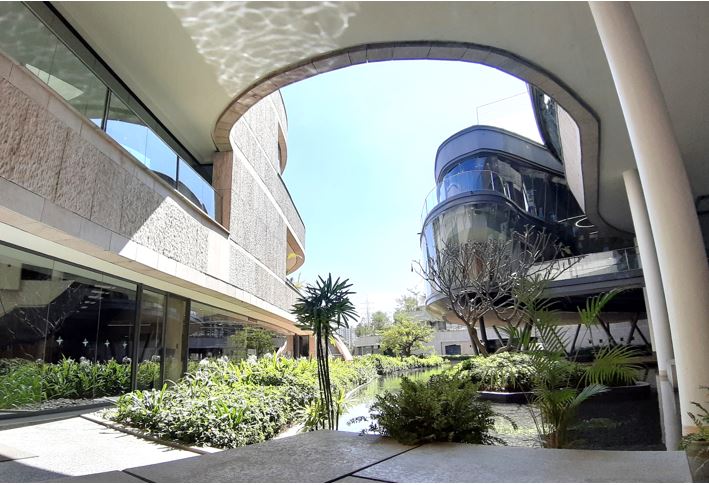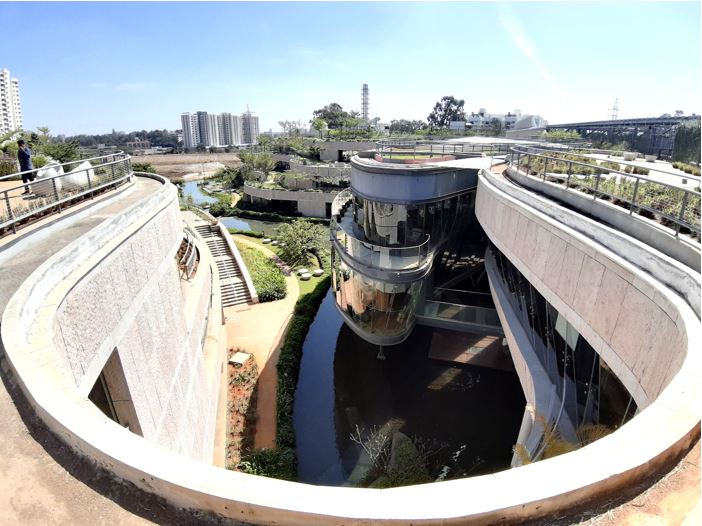Titan campus in Bangalore
Contents |
[edit] Introduction
Greenery is often lacking in many developed urban cities. Tall skyscrapers create a jungle of concrete; this is what human beings have made in the few last decades.
Instead, is it possible to make buildings that become a part of nature by merging the green and the IoT world?
At the the Titan Integrity Campus in Bangalore, architects applied this strategy to create a building that integrates with nature. The project resulted in a 30% reduction in energy consumption and also achieved a five-star Green Rating for Integrated Habitat Assessment (GRIHA).
[edit] Bringing nature inside
The longer sides of the building face north, which brings in glare-free natural light. The interior of the building also has light sensors to balance the environment with sunlight and control the appropriate levels for the working environment.
The breeze passes through the building so common spaces are open and do not require air conditioning. To cut off the western sun, green walls and green buffer spaces are created for a non-obstructing workflow.
What makes this building different is not just its biophilic design but also the reflection of the architect’s love for curves and parametric design.The lake around the building gives office workers the sense they are in a zone to play and work, and they are free to roam around the building through long pathways linking all the floors and different blocks.
Material selection and green construction techniques (such as topsoil conservation and reuse of gunny bags for column curing) add to the building's environmentally sensitive approach.
[edit] Related articles on Designing Buildings Wiki
- Biophilic design.
- Biotechnology: The key to zero energy buildings.
- Environmental - sustainable - green design.
- Green building.
- Sustainability.
[edit] External references
Featured articles and news
Professional practical experience for Architects in training
The long process to transform the nature of education and professional practical experience in the Architecture profession following recent reports.
A people-first approach to retrofit
Moving away from the destructive paradigm of fabric-first.
International Electrician Day, 10 June 2025
Celebrating the role of electrical engineers from André-Marie Amperè, today and for the future.
New guide for clients launched at Houses of Parliament
'There has never been a more important time for clients to step up and ...ask the right questions'
The impact of recycled slate tiles
Innovation across the decades.
EPC changes for existing buildings
Changes and their context as the new RdSAP methodology comes into use from 15 June.
Skills England publishes Sector skills needs assessments
Priority areas relating to the built environment highlighted and described in brief.
BSRIA HVAC Market Watch - May 2025 Edition
Heat Pump Market Outlook: Policy, Performance & Refrigerant Trends for 2025–2028.
Committing to EDI in construction with CIOB
Built Environment professional bodies deepen commitment to EDI with two new signatories: CIAT and CICES.
Government Grenfell progress report at a glance
Line by line recomendation overview, with links to more details.
An engaging and lively review of his professional life.
Sustainable heating for listed buildings
A problem that needs to be approached intelligently.
50th Golden anniversary ECA Edmundson apprentice award
Deadline for entries has been extended to Friday 27 June, so don't miss out!
CIAT at the London Festival of Architecture
Designing for Everyone: Breaking Barriers in Inclusive Architecture.
Mixed reactions to apprenticeship and skills reform 2025
A 'welcome shift' for some and a 'backwards step' for others.























